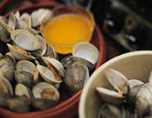
SHELLFISH SAFETY
It is very important that anyone planning to harvest or consume local, recreationally-harvested shellfish check the status of shellfish harvesting before consuming any shellfish.
 IMPORTANT:
IMPORTANT:
* There is no change to the taste, odor, or appearance of shellfish with high levels of marine biotoxins, or seafood or shellfish contaminated by Vibrio bacteria.
* Shellfish harvested commercially that are available in stores and restaurants are tested for biotoxins and bacteria prior to distribution, and are safe to eat.
Marine Biotoxins
Molluscan shellfish (clams, oysters, mussels, and others that have a hinged shell) are filter feeders. They pump water through their systems, filtering out and absorbing any particles that are in the water.
The main food source for molluscan shellfish is microscopic algae. Some microscopic algae produce toxins, called biotoxins, that don't harm shellfish but can cause illness or death in people who eat them. Molluscan shellfish also absorb anything else that's in the water including bacteria, viruses, and contaminants. These can accumulate to the point where the shellfish become unsafe to eat.
Marine biotoxins are not destroyed by cooking or freezing and can be life-threatening. People can become ill from eating shellfish contaminated with the naturally occurring marine algae that contain biotoxins that are harmful to humans. In most cases, the algae that contain the toxins cannot be seen and must be detected using laboratory testing. Shrimp and crab are typically not included in biotoxins closures, but crabs should be cleaned prior to cooking, and the “crab butter” should be discarded.
The most commonly found biotoxins found in Washington’s marine waters include:
Paralytic Shellfish Poison (PSP)
Symptoms of PSP can appear within minutes or hours and usually begin with tingling lips and tongue, moving to the hands and feet, followed by difficulty breathing and potentially death. Anyone experiencing these symptoms should contact a health care provider. For extreme reactions, call 911.
Diarrhetic Shellfish Poison (DSP)
Symptoms of DSP causes nausea, vomiting, abdominal pain, and diarrhea, with diarrhea being the most commonly reported symptom.
Amnesic Shellfish Poison (ASP)
 ASP symptoms include vomiting, nausea, diarrhea, and abdominal cramps within 24 hours of ingestion. In more severe cases, neurological symptoms develop within 48 hours and include headache, dizziness, confusion, disorientation, loss of short-term memory, motor weakness, seizures, profuse respiratory secretions, cardiac arrhythmias, coma, and possible death. Short term memory loss can be permanent.
ASP symptoms include vomiting, nausea, diarrhea, and abdominal cramps within 24 hours of ingestion. In more severe cases, neurological symptoms develop within 48 hours and include headache, dizziness, confusion, disorientation, loss of short-term memory, motor weakness, seizures, profuse respiratory secretions, cardiac arrhythmias, coma, and possible death. Short term memory loss can be permanent.
There are many myths and misconceptions about marine biotoxins. Questions or concerns about shellfish safety? Call us
Vibriosis in Shellfish
Vibriosis is an intestinal disease caused by small bacteria called vibrio. Vibrio parahaemolyticus is a naturally occurring bacterium found in marine waters, particularly those waters with low salinity levels such as bays and estuaries. The bacterial population is typically greatest during the summer months when water temperatures rise. Vibrio parahaemolyticus bacteria is not a result of pollution.
Vibrio parahaemolyticus is destroyed by cooking shellfish to an internal temperature of 145° F for 15 seconds. Eat only well-cooked shellfish, especially in summer months. Do not consider shellfish to be fully cooked when the shells just open; they need to cook longer to reach 145° F.
Individuals exposed to Vibrio parahaemolyticus may display various symptoms including nausea, vomiting, abdominal pain, diarrhea, fever, chills, and the formation of blistering skin lesions.
For information on shellfish harvesting closures, click here.
Norovirus in shellfish
Shellfish can be a source of norovirus illness, especially in colder months (November - March). Norovirus is a virus that causes a highly contagious illness commonly referred to as viral gastroenteritis, stomach flu, and food poisoning. Cooking can reduce the risk of norovirus illness, but the virus can survive at temperatures up to 140ºF. Quick steaming or cooking until the shells just open is not enough to protect against norovirus illness.
Risks of eating raw seafood and shellfish
For most people, eating raw seafood or shellfish carries a small risk of illness. But for others, the consequences can be dangerous and even deadly. For people at high-risk for foodborne illness, severe and life-threatening illness may result from consuming raw or undercooked fish and shellfish. These individuals include those with compromised immune systems or with decreased stomach acidity, as well as pregnant women, infants, young children, and older adults. Raw fish and shellfish consumption is never advised for high-risk individuals. If you're in this category, thoroughly cook fish and shellfish. If you're unsure of risk level, consult with your physician or registered dietitian nutritionist.
Additional Resources:
Shellfish advisories page
General shellfish information
Safe handling, storing and cooking practices
